MIke Piazza
This past week, I was able to interview Anthony Scaramucci regarding him and his partners purchasing the Mike Piazza post 9/11 homerun jersey. I appreciate Mr. Scaramucci purchasing the jersey and taking the time to answer my questions.
Special thanks goes to Mets Merized Online, who not only ran this interview on their site, but also many other of my Mets articles.
I also appreciate the links and recommendations for this interview including being part of Adam Rubin’s Morning Links. My wife was so thrilled she got a screen shot of it:
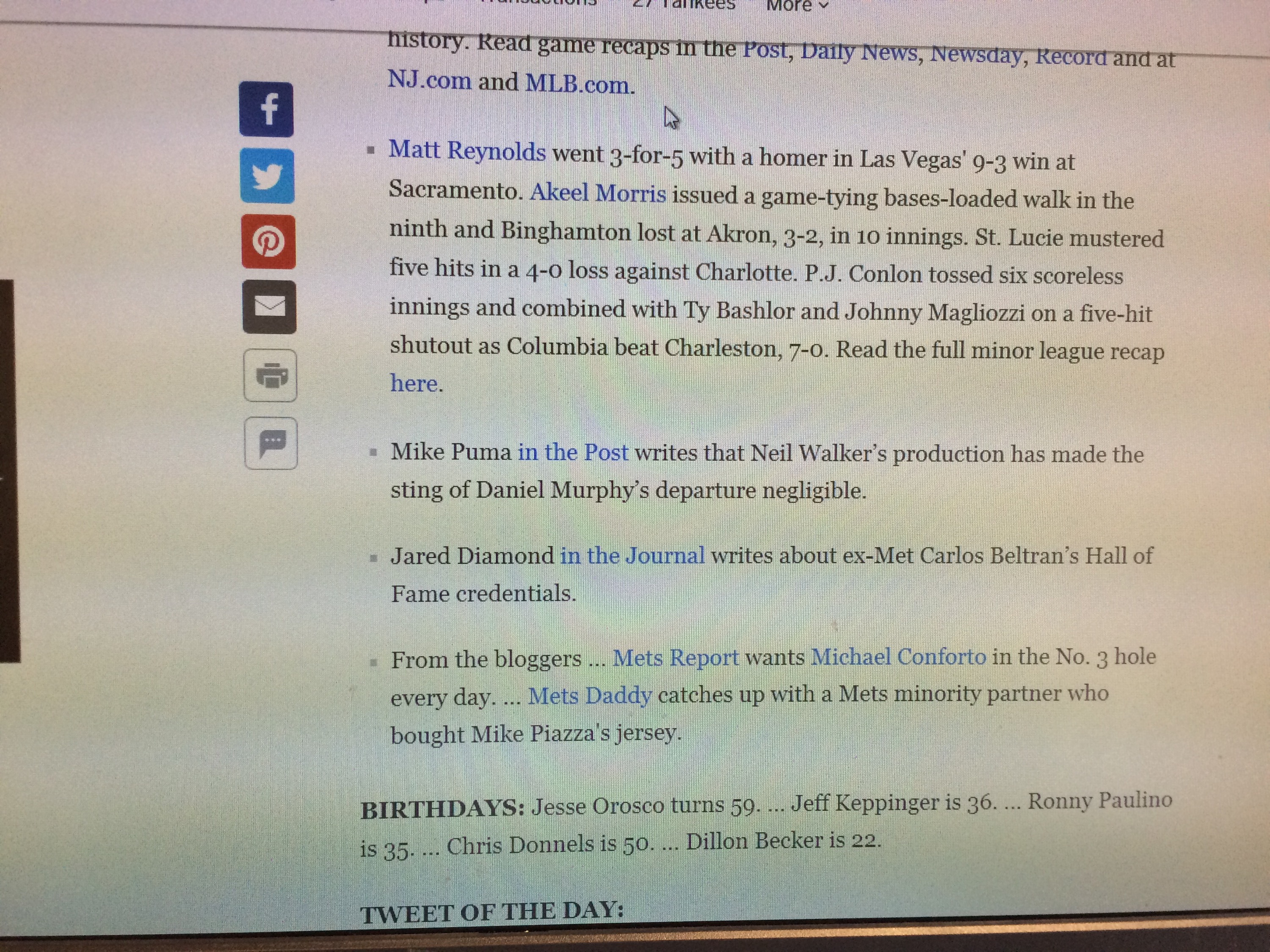
There were also links from SNY and Kevin Kernan, whose reporting brought the issue to light.
I appreciate everyone who linked the interview as well as those who took the time to read it. I especially appreciate those who read the site day in and day out.
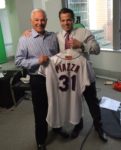
Thanks to Kevin Kernan, we all discovered that Mike Piazza‘s post-9/11 homerun jersey was up for auction with Goldin Auctions. The jersey faced an uncertain future until a group stepped forward and purchased the jersey for a record $365,000. Part of that group included Anthony Scaramucci.
For those who don’t know Mr. Scaramucci, he is the founder and co-managing partner of global investment firm SkyBridge Capital, founder of the SkyBridge Alternatives (“SALT”) Conference and host of iconic financial television show “Wall Street Week.”
Despite his busy schedule, he was able to answer some of my questions regarding his Mets fandom and the Piazza jersey:
How did you become a Mets fan?
Growing up on Long Island, I got hooked in 1969 with the Miracle Mets and the 1973 team that made it back to the World Series. They could have lost every game after that. It wouldn’t matter to a true fan.
What is your favorite Mets memory?
I’d have to say winning the World Series in ‘86. Last year’s World Series run was also a thrill, seeing our young team get back to winning ways. I can’t wait to see what the future holds for the franchise.
What were your recollections from Mike Piazza’s post 9/11 homerun?
The 9/11 attacks had an impact on all Americans, but especially those living in and around New York. It was almost guaranteed that you knew someone directly or indirectly who died that day. There was no precedent for how to respond to such a tragedy. When should life return to normal? Should sports resume, and if so when? Should we play games in New York? I felt very strongly that we needed to get things back to normal as quickly as possible to honor the fallen and send a message to the world that you cannot disrupt our way of life.
In the stadium, everyone was tense and uneasy for most of the game. Players were hesitant to make a hard slide or argue a call. Everyone was sort of going through the motions. When Piazza hit that home run, the place erupted, the old suspension system at Shea was literally bouncing, everyone was hugging each other and there wasn’t a dry eye on the place. It was an outpouring of grief and the beginning of the healing process for New Yorkers and for the country.
What did the jersey mean to you?
The jersey to me is a symbol, a symbol of American resolve and resilience in the face of unspeakable tragedy, a symbol that no matter the adversity we will always pick ourselves up, dust ourselves off and move forward. Some might say it was just a baseball game and it’s just a jersey, but anyone who was there or watching that day knows differently.
Why did you decide to purchase the jersey?
I know the jersey meant a lot symbolically to the people of New York – 9/11 first responders to families of the deceased to fans and former players – and when the opportunity came to get it back my partners and I just couldn’t let the opportunity pass. We wanted to make sure it came back home to New York to be displayed in the public domain forever.
At any point, did you ever consider wearing it around like George Costanza wearing Babe Ruth’s jersey on Seinfeld?
You didn’t think I would pay all that money without trying the jersey on did you? Unfortunately it isn’t quite my size. In true New York fashion, I’ve mostly been carrying it around in a garment bag on a cheap wire hanger.
Where is the jersey first going to be displayed?
We’re not 100% sure on that yet. All three venues where it will rotate (the 9/11 Memorial Museum, National Baseball Hall of Fame and Citi Field) have to figure out some display logistics, so in the meantime we’ll be showing it around and I’m going to bring it out to Las Vegas for the SkyBridge SALT Conference in May. Hopefully the flight stewardess has room to hang it up in the pilots’ closet.
How long will the jersey be on display?
We are writing a clause into the deal so the jersey will forever be displayed in the public domain, hopefully well after we’re dead and gone.
How do you feel when people thank you and your partners for purchasing the jersey?
I’m conflicted on that. On one hand obviously I appreciate the kind words and support, but I also don’t want to pretend like I’m some kind of hero for buying a jersey. There were thousands and thousands of heroes on 9/11 – workers in the towers herding others to safety, first responders rushing up into the burning buildings, volunteers digging through toxic rubble for days on end in hopes of finding one or two miraculous survivors. I feel fortunate that my success has put me in a position to contribute to a gesture like this, but the jersey and this moment isn’t about me, it’s about honoring the legacy of those who died that day.
What are your predictions for the 2016 season?
I’m an optimistic guy, but I think the Mets are going to win the whole thing. We have one of the greatest pitching staffs of all time and it’s going to be fun to see those young guys grow. Management did a great job keeping Cespedes and making some nice additions to the team. It’s going to be a year to remember.
Personally, I would also like to thank him for taking some time out of his busy schedule to answer my questions.
I would also like to thank Mr. Scaramucci and his partners for purchasing the jersey and sharing it with the people of New York. When I tell my son about 9/11, I will also tell him how Piazza’s homerun uplifted New York. Because of Mr. Scaramucci and his partners, I will be able to show the jersey Piazza wore that day to my son.
* picture from Anthony Scaramucci’s Twitter account (@scaramucci)
Editor’s Note: this article also ran on metsmerizedonline.com
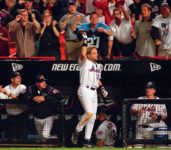
Thanks to three people, Anthony Scaramucci, Tony Lauto, and another in identified buyer (Oliver Stone?), Mike Piazza‘s 9/11 jersey is safe. The trio agreed that the jersey will forever rotate between Citi Field, the 9/11 Museum, and the Baseball Hall of Fame. These three people stepped up and did what was right and what was needed.
They had to step up because Mets ownership wouldn’t. As Kevin Kernan of the New York Post reported, the Mets never made a bid for the jersey.
To be fair, let’s not revisit the past here. We don’t know why the jersey was sold. It might’ve been the result of the financial troubles the Wilpons experienced as part of the Madoff scandal. It could’ve been an oversight. It’s possible no one realized the importance of the jersey. Maybe, just maybe, it was never supposed to be sold in the first place, but it was due to oversight. Fact is we’ll never know why it was sold. Most agree that in retrospect, it was wrong to sell the jersey. The Mets organization admitted as much in their statement to the New York Post stating, “We made a mistake in selling the jersey and Jeff [Wilpon] called Mike [Piazza] to express our regret in doing so.”
With the jersey up for sale, the Mets got that rare opportunity to right a wrong. They chose not to do so. They didn’t despite Jeff Wilpon assuring Piazza the Mets contacted the seller and were “making a concerted effort to get the jersey back.” They didn’t. Instead, they let someone else step in and purchase it.
At this point, it’s inexcusable. They told their newly elected Hall of Famer, they were going to make a concerted effort, and they didn’t. They got lucky because three people not only purchased it, but also agreed it should be on permanent display instead of in one of their homes. The thing is as the owners of that jersey that was their right. That was what the Mets risked.
At this point, we just have to ask,”Why?”
Why didn’t the Mets realize the jersey’s importance in the first place? Why didn’t they make an effort to buy the jersey? Why did they not keep their promise to Piazza? Why didn’t they understand what the jersey meant to the fans? Why were they willing to let the jersey to possibly be sold to someone who didn’t feel the obligation to display the jersey publicly?
The answer to all of these questions, and many more is, at the end of the day, baseball is a business. The owners only care about the fans to the extent that they want to create an environment suitable enough for them to spend as much of their disposable income on the team as possible. To Mets ownership, the Piazza 9/11 jersey didn’t have any special meaning. Rather, it was a jersey: (1) that could be sold for a profit; and (2) whose current purchase price was cost prohibitive. Pure and simple, these were business decisions.
The Mets will continue to make business decisions like they’ve always done. They’ll sell bricks which line the outside of Citi Field, but they won’t erect a Tom Seaver statue. They won’t sign a player like Yoenis Cespedes, despite the fans’ attachment to him, unless it is at a price suitable to them. For better or worse, that’s how the Mets operate.
And that’s all the Piazza 9/11 jersey decisions were to them – business decisions.
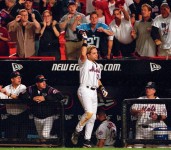
The Wilponzi Era was about as difficult a time as I’ve experienced as a Mets fan. You can argue that after bad trades and bad free agent signings. We can have a real debate about whether or not it was time to break it down and rebuild. However, what the Mets and their fans went through was so much more than that.
The news of the scandal broke in December 2008 as the Mets closed Shea Stadium and were on their way to open Citi Field. Despite the distraction, the Mets opened the season with a the second highest payroll in baseball at a little over $149 million. The team would suffer injury after injury before falling way out of contention. In 2010, despite payroll dropping about $20 million, they did try to improve the club by signing Jason Bay. As we know neither Bay nor the 2010 season worked out well.
In subsequent seasons, the Mets made no major free agent acquisitions. How could they? The Wilpons lost at least $178 million. They were named defendants in the Madoff case and were sued for $1 billion. The Wilpons were forced to do whatever they could do to keep control of the Mets. They initially took out $65 million in loans from Major League Baseball and Bank of America. In total, the Mets borrowed over $980 million. Of that amount, $430 million was borrowed using the Mets as collateral.
The once $149 million payroll dropped down to $85 million (ranked 21st in the league). The Wilpons were facing a financial crisis, and they were doing everything they could go to go from being bankrupt. They began selling minority stakes in the team. They were trying to keep their main assets, which included the Mets.
As fans, we believed the most damaging effects of this was in the Win-Loss column. We believed it was the Mets being unable to put a winning, if not at times competitive, team on the field. We were very wrong.
Thanks to Kevin Kernan we now know what the most damaging effects of the Wilponzi Era was the sale of the jersey Mike Piazza wore when he hit this homerun:
This moment means different things to different people. I know I shed a tear when it happened. In my opinion, it is amongst the top three moments in Mets history along with ’69 and ’86. It may mean something different to you. You may fell differently. That’s fine. We all acknowledge it was a powerful moment in history.
Here’s the thing. As much as the moment means to everyone, and as much as the jersey means, I don’t blame the Wilpons for selling it. In fact, I think they deserve some credit.
Being objective, if you’re the Wilpons owning the Mets is much more important than that jersey. If you lose the team, you lose the jersey. Looking at Kernan’s article, they did a private sale, and they arranged to have the jersey displayed in the Mets Hall of Fame.
The Mets settled the Madoff case for $162 million seemingly around the same time as the Piazza jersey was sold. They got the infusion of cash they needed while still having the ability to share the jersey with the fans. Remember, the Wilpon’s settlement in the Madoff case called for turn
However, as we now know, the Mets selling the jersey also meant the Mets lost control over the jersey. It could be sold without their permission, and it can be taken out of the Mets Hall of Fame to someone who wants to do whatever it is they want to do with it.
If you want to be angry with someone, be angry with Major League Baseball. They are the ones that allowed this to happen. This is the same organization that forced Frank McCourt out. McCourt committed two crimes. The first was he sought a $200 million loan to the Dodgers and a $30 million loan to him personally from Fox. The second was he wasn’t in good with Bud Selig. The Wilpons were.
The Wilpons had similar crippling debt and a desperation for money. In fact, they borrowed more than McCourt ever sought to borrow – over three times the amount. However, the Wilpons went about it the way Major League Baseball wanted. They made sure to keep in Selig’s good graces.
The Wilpons were empowered by Major a League baseball to cut the payroll nearly in half. Major League Baseball empowered the Wilpons to refuse to sign a free agent of real consequence. Major League Baseball empowered the Wilpons to start selling off memorabilia to stay afloat. The Wilpons were probably doing all they needed to do to keep the Mets. They were just the people ripping the copper wiring out of the walls.
With that said, their free pass on this issue ends right now.
According to Kernan’s article, it is anticipated that Piazza’s jersey will sell for north of $300,000. The good news for the Mets is they released Ruben Tejada. In doing so, the Mets saved approximately $2.5 million. There is plenty of money to allocate from those savings to permit the Mets from re-acquiring a jersey they should never have been in a position to sell in the first place. There’s no excuse this time.
Despite all of this, the Wilpons are not moving heaven and Earth to get that jersey back. According to Kevin Kernan’s latest article, the seller, Goldin Auctions, will make the jersey available for sale before the auction due to the significance of the jersey. It is something the seller has never done before, but it acknowledges the importance of not only the jersey, but also where the jersey belongs. The seller believes the jersey belongs at the 9/11 Memorial. Mets fans believe it belongs in the Mets Hall of Fame, but certainly wouldn’t object to it being placed at the 9/11 Memorial.
Despite this, the Wilpins have yet to make an offer for the jersey despite having an extra $2.5 million in their coffers from Tejada’s release. They are merely monitoring the situation gauging fan reaction. This sounds just like the Wilpons’ behavior when Piazza was a Marlin on the trading block. Don’t spend the money until the fan backlash is too fervent for you not to make the move. Well, the stakes are higher this time. It’s time for the Wilpons to stop waiting around. It’s time for action.
The Wilpons need to make sure they do everything they can to bring that jersey back to the Mets Hall of Fame where it belongs.
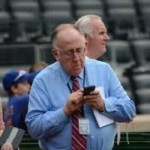
The Mets really are their own worst enemies, and it all starts with what is a terrible Public Relations Department.
The Mets’ ace, Matt Harvey, was dealing with a private medical issue. He had blood clots in his bladder. The causes for blood in the urine can be scary. It can be caused by kidney stones, cancer, or in Harvey’s case, holding it in too long. The number one thing to take from this whole situation is that Harvey is healthy, and he will be ready to pitch on Opening Day.
However, that doesn’t mean there isn’t a problem here. Why did Matt Harvey have to go through this publicly at all?
Harvey had tests and a procedure done by this morning. The Mets could’ve said Harvey was going to miss today’s Spring Training start because he had the flu, or they wanted to give someone else a start while Harvey threw on the side, or literally anything else where you don’t announce to the world that Harvey is dealing with a private medical issue. While he is dealing with this, many people are cracking jokes or making nasty comments. Well, Harvey noticed:
Matt Harvey also chided people for the "nasty things" they speculated his condition might be. He's fine now. #Mets
— Anthony DiComo (@AnthonyDiComo) March 29, 2016
Again, why was Harvey subjected to this? In part, it’s because people like to make jokes. The bigger issue is the Mets made an announcement before one needed to be made. They made a private matter a public matter and subjected their ace to ridicule. By the way, now that the news is out that Harvey is alright, new jokes have emerged. This is a failure of epic proportions by the Mets organization.
It’s not the first time Mets players have had a real issue with how the front office, and specifically Jay Horowitz, prioritizes the media over its own players. As Mike Piazza wrote in his autobiography, Long Shot (p. 259):
Because I’d the huge shadow the Yankees cast in the city, it seemed to me and other players that the Mets chronically catered to the press in the continual effort to get attention. In the process, they often exposed us – almost sacrificed us, in effect – to the jaws of the New York media monster. Our publicity director, Jay Horowitz, was a good guy who worked hard and loved the ball club, but I felt that he was more loyal to the writers and broadcasters than he was to the players.
******************
[The front office’s] position seemed to be that players come and go but the stations and newspapers will always be around. The effect, for us, was a sense that we were constantly walking the plank with the sharks circling below.
Once again, the Mets were more concerned about playing nice with the media rather than protecting one of its players. It was a problem with Piazza. It still seems to be a problem today.
So overall, the Mets have no problem sacrificing their players and their privacy to the media. They have no issues subjecting their players to ridicule for what are serious health issues. Harvey deserved better than this. Piazza and his teammates deserved better when they were playing.
The funny thing is that while the Mets have no problem having their players have to answer questions about private matters like their health, they are still ducking the media when it comes to the Madoff scandal or Jeff Wilpon firing a single mother. You see the Mets cozying up with the media only works when it comes to their players. When it comes to their own issues, they are nowhere to be found.
There will be jokes that follow Harvey the rest of his career because of this. It never needed to happen. The Mets failed one of their players by subjecting him to mockery and ridicule they don’t allow themselves to face. The Mets front office is the real joke here.

In honor of Pi Day, let’s look at all the things to look forward to during the 2016 season:
3.1 – Mike Piazza
This summer Mike Piazza is going into the Hall of Fame as a Met. He’s the first Mets position player to do so. The following weekend, he will also be the first Mets position player to have his number retired. He will forever be remembered for all of his homeruns, especially the homerun after 9/11. More importantly, he will forever be a Met.
41 – Tom Seaver
Seaver is the greatest Met to ever wear the uniform, and perhaps, the greatest right handed pitcher of all time. He was rightly dubbed “The Franchise.” With him, he began the aura of the Mets always having good pitching. This year his mantle will be picked up again by a dominant young staff reminiscent of the pitching staffs Seaver was a part of back in his day.
59 – Antonio Bastardo
Bastardo is one of a few key free agents the Mets added this offseason. Last year, the Mets had bullpen problems forcing them to overuse Jeurys Familia and trade a lot of good young pitching away to build a bullpen around the trade deadline. This year, Bastardo is a key arm in what appears to be a bullpen worthy of holding down the leads handed to them from their dominant starting pitchers.
26 – Kevin Plawecki
Plawecki had a rough 2015 whether it was because of him being rushed to the majors too soon or him needing sinus surgery. Given Travis d’Arnaud‘s injury history, it is very possible Plawecki is going to get another shot at being the Mets starting catcher next year. At some point, he will be called upon to not only continue his tremendous work as a receiver, but also being a more potent bat to the Mets lineup.
5 – David Wright
The biggest question mark in the 2015 season is how much David Wright can play and how effective he can be over the course of a 162 game season. Wright is the team leader and Captain, and they’re going to need him. At the end of 2015, he showed he can still hit and be an important part of the Mets. They’re going to need him at some point next year.
35 – Logan Verrett
After losing Verrett in the Rule 5 draft last year, he’s back with the Mets organization. Last year, he was an important swing man. He was first a bullpen arm and later a spot starter who gave a young pitching staff some rest before the postseason. In 2016, Verrett is likely to serve a similar role regardless of where he starts the year. At some point, the Mets will need him, even if it’s just to get the starters some rest before another postseason run.
89 – The Closing of a Window
After the Mets lost in the 1988 NLCS, there was no reason to believe that was the end of their window. There were veterans on the team, but there were also prospects behind them and rising stars on the team. There was still the pitching. It’s a stark reminder that when the window is open, you do everything you can in that timespan. You never know when that window closes.
79 – Paul Sewald
Sewald is just one of a number of Mets pitching prospects who are chomping at the bit to get called-up to the majors. Sewald has had a 1.83 ERA in his entire minor league career. If he continues pitching this well, he very well might get a call-up in the event there is an open bullpen spot this year.
32 – Steven Matz
In Matz’s first two career starts, he was incredible on the mound and at the plate. Even after his injuries, he has shown flashes of brilliance. He’s an early leader in the Rookie of the Year race. He’s primed to become the next great Mets starting pitcher. In 2016, he needs to stay healthy and take that next step.
38 – Dan Warthen
Warthen and the entire Mets organization have been blessed with amazing pitching. It’s encumbent upon Warthen to not only help each of these pitchers take the next step in their development, but also to help keep them healthy over the course of a full season.
4 – Wilmer Flores
We end with Flores, who was the last Mets to bat in the 2015 World Series. Flores was the player who cried at the possibility of leaving the Mets to a fan favorite. He has gone from the starting shortstop to a utility/platoon player. The 2016 Mets are a heavy left-hand hitting team. Flores can balance this out in his role as a super sub.
He’s also the first choice for third base in the event that Wright needs to sit or go on the DL for long stretches of time. He’s the primary backup at every infield position. He’s going to be an extremely important piece for the Mets.
They are all important actually. As we saw in 2015, a team will have to go deep into their roster at times. However, by building a strong 25 and 40 man roster, as the Mets have now, you give your team the best chance to make it to the postseason. Hopefully, the Mets can come full circle (pi pun) in 2016, and win the World Series.
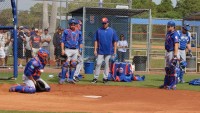
I don’t care what is happening. The Mets could be coming off a World Series appearance. The Mets could have traded everyone away in Marlins fashion. It doesn’t matter. It’s always good to see Mike Piazza with the Mets.
He’s back as a special instructor. He is there to work with Travis d’Arnaud and Kevin Plawecki. It makes sense to have a Hall of Fame catcher work with a budding All Star and prospect. Terry Collins intends gave Piazza more latitude than just working with the catchers. For example, Piazza took the time and the initiative to talk with Yoenis Cespedes about being a superstar in New York.
With his appearance at Spring Training, it did get me thinking about when and if Piazza would ever manage in the big leagues.
Right now, the Mets manager is Terry Collins, and there is no reason to believe that’s going to change soon. Collins received a two year extension. He supposedly wants to manage these next two years and then retire. The question them arises as to who the next Mets manager will be.
One trend that never seems to go away is hiring a former star to lead the team. Robin Ventura manages the White Sox. Paul Molitor manages the Twins. Ventura had no managing experience. Molitor had experience as a minor league instructor.
Piazza only has experience as the hitting coach for Team Italy. He has been well regarded in his work as the hitting coach. He has also worked with catchers and ran instructional clinics. This year has been his first year back at Spring Training with the Mets in two years. Most likely, this stint is the Mets inviting their Hall of Famer to spend time with the team. Who’s to say it can’t be more.
At one point in time, Piazza stated he envisioned returning to baseball in some capacity. He has always kept in touch with the Mets. As of right now, he’s enjoying his time, but he wants to let this team get ready for the season. He’s not overstaying his welcome. He seems content with a few days in Spring Training for now. Maybe with young children that’s all Piazza will ever want.
Two years is a long time. If Piazza wants to return to the Mets in a full time capacity, the door should always be open. No, they shouldn’t hand him a manager job. Still, there’s always room for a person with Piazza’s baseball acumen and ability to handle New York. He may just want to be a special instructor.
No matter what that future role may be, it’ll be great to see Piazza in a Mets uniform imparting his wisdom to the next generation of Mets players.
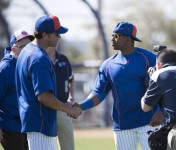
When Mike Piazza first came to the Mets, he was treated as the rock star he was. With him finally came the dreams of postseason berths and World Series titles.
Then something bizarre happened. He struggled, and he was booed. I still don’t understand it, but it happened. Piazza was incredible when he came to the Mets. With the Mets floundering, Piazza took his play to another level carrying the Mets ever so close to the Wild Card. With the treatment he received, Piazza had every reason to walk, but he didn’t he stayed. He wanted to be a superstar in the biggest market.
This is why he’s the perfect person to give advice to Yoenis Cespedes.
Cespedes came to the Mets, and he was a rock star. His coming to the Mets coincided with them taking control of the NL East. Unlike Piazza, Cespedes never received the boos. To that extent, he was a bit lucky. After Cespedes was hit on the hand, his play declined. He went from Babe Ruth to Mario Mendoza. In the final 18 games of the 2015 season, he only hit .220/.288/.373 with one homerun and four RBI. However, the NL East was sown up. He wasn’t going to receive boos.
The closest anyone would come was in the World Series. He missed player introductions before Game Three. After an uneven postseason, he fell apart in the World Series. He misplayed Alcides Escobar‘s flyball into an inside-the-park homerun. He hit .150/.143/.150 with six strikeouts in the series. Perhaps it was the shoulder injury. Maybe it was the moment.
No one would boo. Fans don’t boo you in the postseason unless you’re Bobby Bonilla. However, his play was poor enough that fans were initially ready to let Cespedes walk.
However, with an initially less than optimal offseason, Mets fans wanted Cespedes back. He wanted to come back too. All of what drove Mets fans crazy has been forgotten. Fans are re-embracing him. They love the cars. They love his little quirks. It’s a second honeymoon. That doesn’t mean that the fans won’t boo him this upcoming season.
Cespedes is notoriously streaky. As far as fans are concerned, he’s the face of the team. One long cold streak coinciding with a struggling Mets team could bring out the boo birds instead of the parakeets. It’s exactly what Piazza had to deal with 18 years ago. It’s the reason why Cespedes and Piazza need to talk.
Piazza can walk him through what it means to be a superstar in New York. He can tell him how to deal with the booing. He can share how the fans lifted him up when he needed it. He knows the ins and outs of being the a superstar on the Mets. That’s what Cespedes is now.
Fortunately, Cespedes has a Hall of Famer he can lean on to prepare for it.
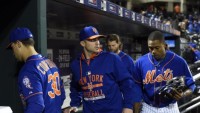
It is surreal to think it was only 12 years ago that David Wright was walking into Mike Piazza‘s clubhouse. Now, with Piazza being retired, it’s now Piazza’s turn to walk into Wright’s clubhouse:
For the Twitter folks: David Wright welcomes Mike Piazza to #Mets camp on Sunday morning: pic.twitter.com/Yq9k7jLkxz
— Adam Rubin (@AdamRubinMedia) February 28, 2016
Back then, everyone on the team knew how good Wright was going to be. They saw him as their best chance of ever winning a World Series. They all took him under their wing.
Piazza mentored Wright how to handle New York and how he should listen to his body. In he following Spring Training, Carlos Beltran took Wright with him for extra workouts to show him the type of off-the-field work is needed to succeed in the major leagues. Cliff Floyd took him under his wing. Not only did he have Wright carry his luggage, he also showed him how to be a big leaguer.
It’s now Wright’s turn to return the favor. Seeing the Noah Syndergaard lunch incident last Spring, he appears ready, willing, and able. Now, it worked with Syndergaard because he was a player that wanted to get better.
There are still plenty of young Mets players who could learn a lot from Wright. Each of these players should be glued to Wright’s hip learning as much as they possibly can from him. Like Piazza, Beltran, and Floyd, Wright can teach these players how to handle New York, how to listen to your body, how to prepare for a season, and how to be a big leaguer. The one player who j think can most benefit right now from Wright’s wisdom is Michael Conforto.
Conforto is in the same spot Wright once was. He’s on a team with great players. Success in the majors seemingly came easy to him in his first half season. If the Mets do anything going forward, it’s going to be his bat that’s going to be a big part of it. He’s also still young with a lot to learn.
Like David Wright all those years ago, we all see greatness in Michael Conforto. Wright should be helping Conforto prepare himself not just for this season, but for his entire career. Helping Conforto could be the key to Wright getting that elusive World Series ring. Listening to Wright could be the key to Conforto having a long and successful Mets career. They need each other.
Who knows? Maybe 12 years from now, we will get to see Conforto welcoming a retired Wright into his clubhouse.

It’s that time of the year when we get that warm and fuzzy feeling. It’s a time when you feel even closer to what you love. I am of course referring to Pitchers and Catchers reporting to Spring Training this week.
As the Mets report, they are trying to do something that only Bobby Valentine’s Mets have ever done. They are trying to go to the postseason for consecutive years. It’s still amazing to think that in the 54 year history of the Mets, they have only e been in consecutive postseasons only once. Gil Hodges couldn’t do it. Davey Johnson couldn’t. Willie Randolph came agonizingly close.
No, the only one to do it was Bobby V. He did it with a core of Mike Piazza, Edgardo Alfonzo, Robin Ventura, and Al Leiter. He had a terrific bullpen of Armando Benitez, John Franco, Turk Wendell, and Dennis Cook. Each year, he had drastically different outfields and rotations. Yet, he was still able to make it work. He got the most out of these teams. The Mets made consecutive NLCS appearances, and they were close to winning a World Series.
This now is the task set forth for Terry Collins. For the first time in 16 years and the second time in Mets history, he is tasked with leading a Mets team to consecutive postseason berths. Like Bobby V, he has a strong core of players. Unlike Bobby V, he has not had much turnover in the roster.
Overall, the one thing uniting Bobby V’s Mets and Terry Collins’ Mets is hope. Mets fans hope and believe in this team. We all believe this is our year even after a heartbreaking loss. And yes, as this is Valentine’s Day, Mets fans love their team.
So remember on this the coldest of Bobby Valentine’s Day, Spring is in the air, and we will soon be reunited with the team we love.